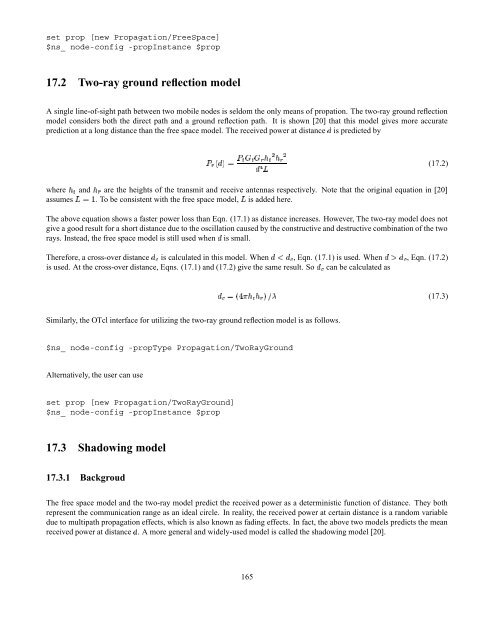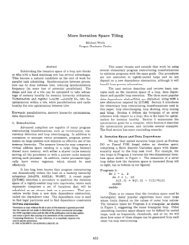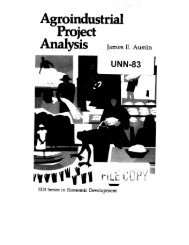Chapter 17 Radio Propagation Models
Chapter 17 Radio Propagation Models
Chapter 17 Radio Propagation Models
You also want an ePaper? Increase the reach of your titles
YUMPU automatically turns print PDFs into web optimized ePapers that Google loves.
set prop [new <strong>Propagation</strong>/FreeSpace]<br />
$ns_ node-config -propInstance $prop<br />
<strong>17</strong>.2 Two-ray ground reflection model<br />
A single line-of-sight path between two mobile nodes is seldom the only means of propation. The two-ray ground reflection<br />
model considers both the direct path and a ground reflection path. It is shown [20] that this model gives more accurate<br />
prediction at a long distance than the free space model. The received power at distance is predicted by<br />
¢¡ ¢ <br />
¡£<br />
(<strong>17</strong>.2)<br />
£¢<br />
¡£¢¥¤ §¦©¨<br />
¢<br />
. ¨ where and are the heights of the transmit and receive antennas respectively. Note that the original equation in [20]<br />
assumes To be consistent with the free space model, is added here.<br />
The above equation shows a faster power loss than Eqn. (<strong>17</strong>.1) as distance increases. However, The two-ray model does not<br />
give a good result for a short distance due to the oscillation caused by the constructive and destructive combination of the two<br />
rays. Instead, the free space model is still used when is small.<br />
Therefore, a cross-over distance ¥¤ is calculated in this model. When §¦ ¥¤ , Eqn. (<strong>17</strong>.1) is used. When §¨ ©¤ , Eqn. (<strong>17</strong>.2)<br />
is used. At the cross-over distance, Eqns. (<strong>17</strong>.1) and (<strong>17</strong>.2) give the same result. So ¤ can be calculated as<br />
¤ ¨ ¤ ¥ ¢ ¦ <br />
(<strong>17</strong>.3)<br />
Similarly, the OTcl interface for utilizing the two-ray ground reflection model is as follows.<br />
$ns_ node-config -propType <strong>Propagation</strong>/TwoRayGround<br />
Alternatively, the user can use<br />
set prop [new <strong>Propagation</strong>/TwoRayGround]<br />
$ns_ node-config -propInstance $prop<br />
<strong>17</strong>.3 Shadowing model<br />
<strong>17</strong>.3.1 Backgroud<br />
The free space model and the two-ray model predict the received power as a deterministic function of distance. They both<br />
represent the communication range as an ideal circle. In reality, the received power at certain distance is a random variable<br />
due to multipath propagation effects, which is also known as fading effects. In fact, the above two models predicts the mean<br />
received power at distance . A more general and widely-used model is called the shadowing model [20].<br />
165














![Problem 1: Loop Unrolling [18 points] In this problem, we will use the ...](https://img.yumpu.com/36629594/1/184x260/problem-1-loop-unrolling-18-points-in-this-problem-we-will-use-the-.jpg?quality=85)

